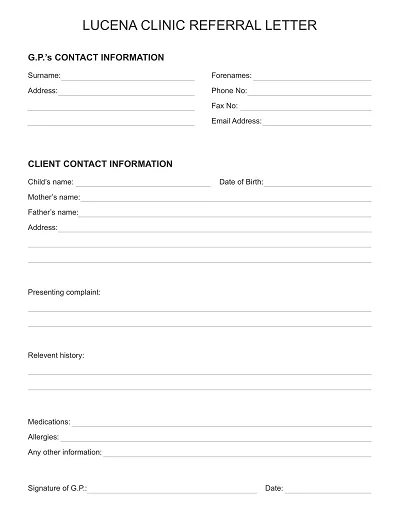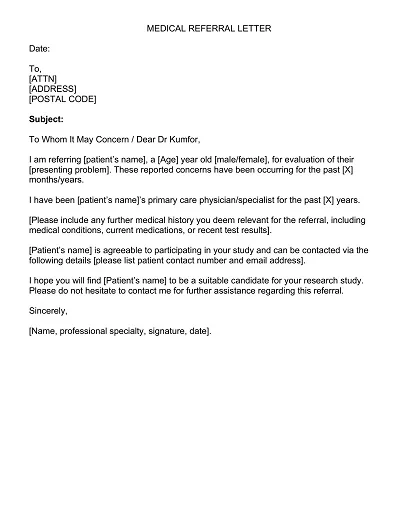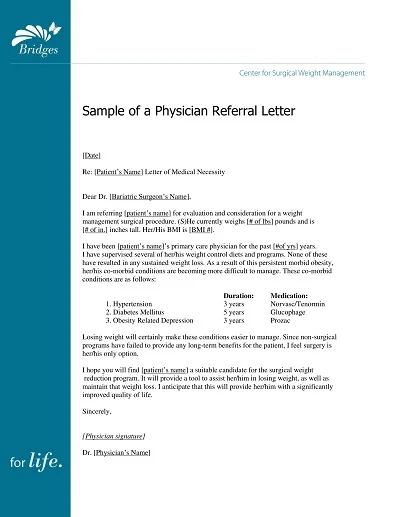A medical referral letter template is a standardized document that healthcare providers use to introduce and recommend a patient for consultation with a specialist or another healthcare professional. This template outlines the patient’s medical history and the reason for referral and includes relevant clinical findings.
It ensures that pertinent details are not omitted and facilitates effective provider communication. The template is a scaffolding for personalizing each letter while maintaining a professional and comprehensive overview of the patient’s needs. It is an invaluable tool that streamlines the referral process, ultimately improving patient care coordination and outcomes.
Download Free Sample Medical Referral Letter Templates
Purpose of a Medical Referral Letter
A medical referral letter’s primary purpose is more than just transferring a patient to a specialist; it is a critical instrument for collaboration in the healthcare continuum. It encapsulates a patient’s health journey thus far and provides a roadmap for future care management.
The referral letter should articulate the necessity for specialized care, offering a summary of relevant clinical information that aids in the prioritization of the patient’s treatment.
This communication tool is fundamental to synthesizing a multi-disciplinary approach to healthcare, ensuring that every medical professional is aligned with the patient’s needs and the proposed treatment strategy.
Components of a Medical Referral Letter
Stakeholders of medical referral letters include healthcare providers, as it is a vital tool used in inter-provincial communication to enhance care delivery. Essential components of a medical referral letter include:
- Patient Information: The name and age information of the person, reservation number, and other details.
- Referring Doctor’s Details: A short bio and contact information, as well as the organization to which the author belongs.
- Medical History: It is pertinent to the patient’s preferred condition and past medical history.
- Purpose of the Referral: The two reasons for referral are as follows: The information that should be provided by the referred specialist and the question being addressed to him.
- Recent Test Results: Pagination NOTE: Be sure to incorporate all current test or imaging data relevant to the referral.
- Current Treatment: Any current medication and treatment regime the patient is undergoing to improve their health status.
- Requested Services: A clear statement of the services or expertise the receiving specialist or institution requires.
- Contact Information for Follow-Up: Details regarding where the specialist can contact the primary care physician to seek more information about the patient or develop the care plan.
Tips for Writing an Effective Medical Referral Letter
Here are some tips for writing an effective medical referral letter:
Be Clear and Concise
The action sought in the case is often best stated directly in correspondence. Ensure all patient details are presented to serve the patient’s best interest while containing only relevant medical details that won’t make the magazine incomprehensible to a lay understanding.
Include Pertinent Medical History
Inform the specialist and summarize all essential aspects of the patient’s previous illnesses, prior treatments, and current medication taken.
Outline the Reason for Referral
You need to indicate why you are sending the patient to another specialist. Descriptions may include interaction with specialists, particularly signs or symptoms, test results or treatment, and outcome.
Set Expectations
It is essential to elaborate on the goals that you have set for the referral and what precisely you expect to achieve. Fundamentally, goal setting assists the specialist, whether it entails receiving a conclusive determination, appeal, or unique treatment since the specialist is informed of expectations.
Provide Contact Information
Provide your phone number and the best time to call if the specialist wishes to clarify something. Healthcare management encourages cooperative interaction between multiple professionals to deliver the best results.
How to Create a Medical Referral Letter Template
While drafting a medical referral letter template, some components should not be omitted as these help the receiving arm healthcare provider make the right decisions. The template should have a professional and easy-to-read layout, including:
- Header: A section at the top with contact information or the letterhead of the practicing hospital or clinic.
- Date: The date on which the referral letter is written or will be submitted to the authority concerned.
- Salutation: The tone and format of the letter can be summarized as a standard business letter with an introduction such as “Dear [Referring Physician’s Name].
- Patient Information: The first and last name of the patient, the year the patient was born, and any possible identification number they may possess.
- Referral Reason: Short description of the referral reason, following the context in particular with the medical concern in question.
- Medical History and Background: It should contain clinical findings relevant to the case presently, medical history, diagnoses made, and if treatment has commenced at all.
- Requested Services: Particular information concerning the consultation or service sought, information which may provide more clarity about the redemption notification from the referrer.
- Closing: End with a formal closing statement such as ‘Sincerely’ or ‘Yours faithfully’ followed by the writer’s full name and professional title.
- Signature: An area that might be utilized for your written or electronic signature.
Please ensure that any non-public information related to the patient is guarded and does not appear in the text. In addition, the language used should be both academic and layman’s understanding for professionals and patients.























